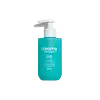What's inside
What's inside
 Key Ingredients
Key Ingredients

 Benefits
Benefits

 Concerns
Concerns

 Ingredients Side-by-side
Ingredients Side-by-side

Water
Skin ConditioningSodium Cocoamphoacetate
CleansingSodium Laureth Sulfate
CleansingMethylpropanediol
SolventDisodium EDTA
Lactic Acid
BufferingZinc Sulfate
AntimicrobialSodium Chloride
MaskingCopper Sulfate
Skin ConditioningPotassium Sorbate
PreservativeXylitol
HumectantFructooligosaccharides
HumectantMannitol
HumectantRhamnose
HumectantPropylene Glycol
HumectantSodium Hydroxide
BufferingGinkgo Biloba Leaf Extract
Skin ConditioningParfum
MaskingWater
Skin ConditioningSodium Cocoyl Alaninate
Glycerin
HumectantPEG-150 Distearate
EmulsifyingCocamidopropyl Betaine
CleansingSodium PCA
HumectantSodium Chloride
MaskingDecyl Glucoside
CleansingCocamide Mipa
EmulsifyingPhenoxyethanol
PreservativePolysorbate 20
EmulsifyingPotassium Laureth-4 Carboxylate
Centella Asiatica Extract
CleansingHydroxypropyl Guar Hydroxypropyltrimonium Chloride
Propylene Glycol
HumectantChamomilla Recutita Flower Extract
MaskingPolyacrylate Crosspolymer-6
Emulsion StabilisingZinc PCA
HumectantSodium Gluconate
Skin ConditioningSodium Citrate
BufferingEthylhexylglycerin
Skin ConditioningPEG-120 Methyl Glucose Trioleate
CleansingT-Butyl Alcohol
PerfumingWater, Sodium Cocoyl Alaninate, Glycerin, PEG-150 Distearate, Cocamidopropyl Betaine, Sodium PCA, Sodium Chloride, Decyl Glucoside, Cocamide Mipa, Phenoxyethanol, Polysorbate 20, Potassium Laureth-4 Carboxylate, Centella Asiatica Extract, Hydroxypropyl Guar Hydroxypropyltrimonium Chloride, Propylene Glycol, Chamomilla Recutita Flower Extract, Polyacrylate Crosspolymer-6, Zinc PCA, Sodium Gluconate, Sodium Citrate, Ethylhexylglycerin, PEG-120 Methyl Glucose Trioleate, T-Butyl Alcohol
 Reviews
Reviews

Ingredients Explained
These ingredients are found in both products.
Ingredients higher up in an ingredient list are typically present in a larger amount.
Propylene Glycol is an odorless, colorless liquid. As a humectant, it helps skin retain moisture. It also aids in delivering active ingredients.
Another role of this ingredient is preventing a product from melting or freezing. Propylene glycol also adds antimicrobrial properties to a product, elongating product lifespan.
This ingredient is considered an organic alcohol and commonly added into both cosmetics and foods.
Those with sensitive skin or conditions may develop a rash when using this ingredient.
Learn more about Propylene GlycolChances are, you eat sodium chloride every day. Sodium Chloride is also known as table salt.
This ingredient has many purposes in skincare: thickener, emulsifier, and exfoliator.
You'll most likely find this ingredient in cleansers where it is used to create a gel-like texture. As an emulsifier, it also prevents ingredients from separating.
There is much debate on whether this ingredient is comedogenic. The short answer - comedogenic ratings don't tell the whole story. Learn more about comegodenic ratings here.
The concensus about this ingredient causing acne seems to be divided. Research is needed to understand if this ingredient does cause acne.
Scrubs may use salt as the primary exfoliating ingredient.
Learn more about Sodium ChlorideWater. It's the most common cosmetic ingredient of all. You'll usually see it at the top of ingredient lists, meaning that it makes up the largest part of the product.
So why is it so popular? Water most often acts as a solvent - this means that it helps dissolve other ingredients into the formulation.
You'll also recognize water as that liquid we all need to stay alive. If you see this, drink a glass of water. Stay hydrated!
Learn more about Water